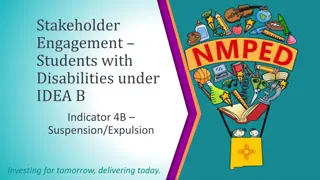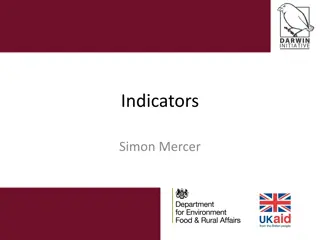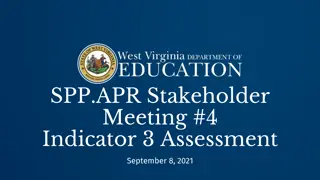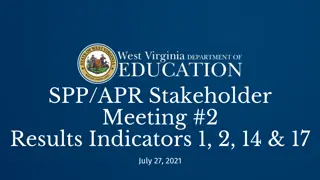State Performance Plan (SPP) & Annual Performance Report (APR) 2020-2025: Child Find and Early Childhood Transition Indicators under IDEA
This document discusses Indicator 11 (Child Find) and Indicator 12 (Early Childhood Transition) under the Individuals with Disabilities Education Act (IDEA) in the State Performance Plan (SPP) and Annual Performance Report (APR) for 2020-2025. It covers measurement methodologies, data trends in New York State, improvement activities, frequently used terms, and key concepts related to evaluation timelines and compliance with state requirements for timely evaluations and transitions.
Download Presentation

Please find below an Image/Link to download the presentation.
The content on the website is provided AS IS for your information and personal use only. It may not be sold, licensed, or shared on other websites without obtaining consent from the author.If you encounter any issues during the download, it is possible that the publisher has removed the file from their server.
You are allowed to download the files provided on this website for personal or commercial use, subject to the condition that they are used lawfully. All files are the property of their respective owners.
The content on the website is provided AS IS for your information and personal use only. It may not be sold, licensed, or shared on other websites without obtaining consent from the author.
E N D
Presentation Transcript
State Performance Plan (SPP)/ Annual Performance Report (APR) 2020-2025 Individuals with Disabilities Education Act (IDEA) Indicator 11 Child Find and Indicator 12 Early Childhood Transition
Agenda: Child Find and Early Childhood Transition Frequently Used Terms for Child Find (Indicators 11 & 12) Indicator 11 How the Measurement Works Indicator 11 Data in New York State (Trends and Comparisons) Indicator 12 How the Measurement Works Indicator 12 Data in New York State (Trends and Comparisons) Indicator 11 & 12 Improvement Activities Next Steps and Closing 2 Agenda Slide for Indicators 11 & 12
Frequently Used Terms Term Description State Performance Plan or SPP Evaluates the state s efforts to implement the requirements and purposes of the Individuals with Disabilities Education Act (IDEA) and describes how the state will improve its implementation Federal Fiscal Year or FFY Federal Government Fiscal Year (October 1 September 30) Annual Performance Report (APR) Data Data reported to the United States Department of Education Office of Special Education Programs (OSEP) against the state s targets Indicator 11 SPP Indicator 11 measures Child Find Evaluation Timelines Indicator 12 SPP Indicator 12 measures Early Childhood Transition Compliant Reason Reasons for a delay in evaluation/transition that are considered to be in compliance with New York State requirements for timely evaluations or early childhood transition Noncompliant Reason Reasons for a delay in evaluation/transition that are considered NOT to be in compliance with New York State requirements for timely evaluations or early childhood transition. CSE Committee on Special Education responsible for conducting timely evaluations for school-aged students suspected of having a disability. CPSE Committee on Preschool Special Education responsible for conducting timely evaluations for preschool aged students suspected of having a disability. Part B of IDEA Special Education services for preschool and school-aged children (3 through 21 years of age) Part C of IDEA Early intervention services (birth through 36 months of age) 3 Frequently Used Terms for Indicator 11 and 12
State Performance Plan (SPP)/ Annual Performance Report (APR) 2020-2025 Individuals with Disabilities Education Act (IDEA) Indicator 12 Measurement
Indicator 12 Early Childhood Transition Indicator 12 measure the percent of children referred by Part C (Early Intervention) prior to age 3, who are found eligible for Part B (preschool special education), and who have an Individualized Education Program (IEP) developed and implemented by their 3rd birthdays. The Indicator 12 measurement calculation removes: # of children referred determined to be NOT eligible and whose eligibility was determined prior to their 3rd birthdays; # of children for whom: parent refusals to provide consent caused delays in evaluation or initial services; parent repeatedly fails or refuses to produce the child for the evaluation; or child enrolls in another school district after consent to evaluate but prior to when a determination of eligibility is made. For those students who did not successfully transition, Indicator 12 reporting includes the range of days beyond the third birthday when eligibility was determined and the IEP developed, and the reasons for the delays. # of children determined to be eligible for early intervention less than 90 days before their 3rd birthdays; and # of children whose parents chose to continue early intervention services beyond the child s 3rd birthday. 5 SPP Indicator 12
Indicator 12 Data Collection in New York State Annually, a statewide representative sample of one-sixth of New York State school districts plus the New York City Department of Education report when specific special education events occur: Code Special Education Event Name EI01 Initial referral to CPSE EI02 Parental consent to evaluate EI03 CPSE meeting to discuss and determine eligibility (all evaluations are completed and IEP developed if determined eligible) Full IEP implementation EI04 All school districts have a choice of reporting data on all eligible students, or they may submit data on a randomly selected sample of a minimum number of students using prescribed sampling guidelines. 6 Indicator 12 Data Collection
Indicator 12 Sample Size: Indicator 12 Measurement Categories and New York State 2019 Reported Data: a. Number of children who have been served in Part C and referred to Part B for Part B eligibility determination. 2,539 b. Number of those referred determined to be NOT eligible and whose eligibility was determined prior to third birthday. 86 c. Number of those found eligible who have an IEP developed and implemented by their third birthdays. 185 d. Number for whom: parent refusals to provide consent caused delays in evaluation or initial services; parent repeatedly fails or refuses to produce the child for the evaluation; or child enrolls in another school district after consent to evaluate but prior to when a determination of eligibility is made. 757 e. Number of children who were referred to Part C less than 90 days before their third birthdays. 4 f. Number of children whose parents chose to continue early intervention services beyond the child s third birthday 1,424 New York State Indicator 12 Measurement Calculation Denominator (a-b-d-e-f) Measure Numerator (c) FFY 2019 Target FFY 2019 Data Percent of children referred by Part C prior to age 3 who are found eligible for Part B, and who have an IEP developed and implemented by their third birthdays. 185 268 100% 69.03% 7 Indicator 12 Sample Size 2019
Facilitator check for understanding on the SPP measurement for Indicator 12 and how the data is used to measure results or outcomes.
State Performance Plan (SPP)/ Annual Performance Report (APR) 2020-2025 Individuals with Disabilities Education Act (IDEA) Indicator 12 Data Trends
Explanation Indicator 12 FFY Data in the Annual Performance Report (APR) Data years presented will reflect the data NYSED submits to the federal Office of Special Education Programs (OSEP) in the APR which covers the federal fiscal year (FFY) period The Indicator 12 data sample is collected on a school-year basis The FFY 2020 APR is submitted to OSEP 2020-21 School Year FFY 2020 APR February 2022 The October 2020 Preschool LRE Data is included in the FFY 2020 APR 10 FFY Data Explanation
Indicator 12: Early Childhood Transition NYS Targets & Results Percent of children referred by Part C prior to age 3, who are found eligible for Part B, and who have an IEP developed and implemented by their third birthdays 100% 90% +19.08 Increase = Improvement 80% +4.38 -6.72 -7.91 70% -15.06 60% 50% 40% 30% 20% 10% 0% 2014 100.00% 75.26% 2015 100.00% 67.35% 2016 100.00% 71.73% 2017 100.00% 56.67% 2018 100.00% 75.75% 2019 100.00% 69.03% Target NYS Results Difference -24.74% -32.65% -28.27% -43.33% -24.25% -30.97% 11 NYS APR Data for Indicator 12
State-to-State Result Comparison: 7-PAK States Indicator 12: Early Childhood Transition 100% 90% 80% 70% 60% 50% 40% 30% 20% 10% 0% New York California Florida Pennsylvania Illinois Texas Ohio 2015 2016 2017 2018 2018 National Mean 12 Indicator 12: APR Reported Data
SPP 12 National & Regional Data Comparison Number of States and Territories by Deciles and Reporting Year (FFY 2014 to FFY 2018) Percent Part B Eligible with IEP by Age Three 2018 2014 2015 2016 2017 90% to 100% 80% to <90% 70% to <80% 60% to <70% 50% to <60% 0% to <50% 49 6 1 0 0 0 54 1 1 0 0 0 53 1 1 1 0 0 52 2 1 0 0 0 50 4 1 0 1 0 3-Year Average New York State District Data (2017-18 through 2019-20) All districts on sampling schedule 7,542 321 502 1,839 33 4,498 348 58.99% NYC sample 4,408 108 145 1,405 0 2,433 317 31.39% Rest of State districts on sampling schedule 3,134 213 357 434 33 2,065 31 91.77% Reason category a. served in Part C and referred to Part B b. determined to be not eligible prior to 3rd birthday c. Part B eligible with IEP by Age Three d. lack of consent or moved prior eligibility determination e. referred to Part C less than 90 days before 3rd birthday f. elected to remain in Early Intervention noncompliant APR rate: c / (a-b-d-e-f) 13 Indicator 12: National and Regional Data
NYS 2019 Compliant Reasons for Delay Indicator 12 Early Childhood Transition Parents chose to continue their child in EI and transition to preschool after the age of 3 2.5% Parent provided consent to evaluate less than 30 school days prior to child's third birthday 4.2% 0.2% 1.4% Parents withdrew or did not provide referral or consent to evaluate 6.7% 0.2% 1.2% Parents refused or repeatedly did not make the child available for the evaluation 0.7% Documented delays in making contact with parents to schedule the evaluation 8.8% The program's starting date and/or days of operation were after the child's 3rd birthday Student moved out of the district 62.2% 12.1% Parents did not provide consent for services DOB is July/August and ESY not part of IEP and IEP implemented in September Parents cancelled the scheduled evaluation and/or selected another approved evaluator Referral to EI less than 90 days from 3rd birthday 14 Indicator 12 Reasons for Delay: Compliant Compared to total Indicator 12 Sample Size for 2019 (2289)
NYS 2019 Noncompliant Reasons for Delay Indicator 12 Early Childhood Transition 2% Evaluator delays in completing the evaluation 10% 1% Evaluator was not available to provide a timely evaluation Delays in scheduling CPSE meetings 17% 51% The recommended Part B program/services were not available when the child turned 3 years of age Additional evaluations were requested 19% Multilingual evaluator was not available to provide a timely evaluation 15 Indicator 12 Reasons for Delay: Noncompliant Compared to the Noncompliant Sample (83 students)
What did the Indicator 12 SPP data tell us? Stakeholder Discussion 16 Stakeholder Question
State Performance Plan (SPP)/ Annual Performance Report (APR) 2020-2025 Individuals with Disabilities Education Act (IDEA) Indicators 11 & 12 Improvement Strategies
Office of Special Education Monitoring: Verification and Follow-Up Reviews For both Indicators 11 and 12, states must report detailed information about the timely correction of noncompliance, information regarding the nature of any continuing noncompliance, improvement activities completed, and enforcement actions that were taken. The Special Education Quality Assurance Offices conducts Indicator 11 and Indicator 12 verification and follow-up reviews,selecting districts on a 6- yearcycle. Targeted monitoring of Indicators 11 and 12 are included in the New York City School District compliance assurance plan (CAP). 18 Office of Special Education Oversight and Monitoring of Noncompliance
Continued Description Indicator 11 & Indicator 12 Monitoring: Verification and Follow-Up Reviews School districts not reporting 100% compliance rates with Indicators 11 or 12 must verify that: 1. All student-specific noncompliance has been resolved; and 2. The district has addressed the reasons for its noncompliance and met compliance standards for all students tracked during a three-month period. These school districts submit assurances that noncompliance has been addressed. SEQA follows up on the district assurances, confirm that the student-specific noncompliance was resolved, and review a sample from the three-month period to confirm compliance was achieved. Indicator 11 Statement of Assurances In the first assurance (Part 1), the district will assure that for each identified student, if any, whose initial evaluation was not completed in compliance with State time lines, and for whom data was not already available in SIRS, has since had his or her initial evaluation completed and if not, there is a reason that is in compliance with State requirements. In the second assurance (Part 2), the district will assure that it has addressed the reasons why the students did not receive their initial evaluations on time and provide data to verify that students for whom parent consent to evaluate was received during a three-month period determined by the district have received their initial individual evaluations within the State required timelines. 19 Office of Special Education Oversight and Monitoring of Noncompliance
Indicator 11 Child Find Guidance In October 2018, the Office of Special Education issued field guidance thatan amendment to Education Law 4410 (Chapter 429 of the Laws of 2017)has made school districts approved preschool evaluatorswithout needing to submit an application to NYSED. OnJune 22,2020,Office of Special Education posted atoolkitfor CPSE s to continue child find responsibilities during the COVID-19 outbreak 20 Preschool Evaluation Guidance
Indicator 12 Early Childhood Transition Materials Photo of "A Resource to Special Education Support Services" The Office of Special Education Preschool Policy Unit partnered with the Office of Early Learning and the New York State Council on Children and Families to issue A Resource to Special Education Support Services. This resource includes important information for families to help navigate the early childhood transition process. NYSED and the New York State Department of Health (DOH) are developing a Memorandum of Understanding (MOU) regarding the Early Intervention Program and Preschool Special Education Programs. The MOU contains agency roles, relevant timelines, data sharing agreements, and process requirements according to the laws and regulations governing both agencies. Indicator 12: Birth 3rd Grade Resource and DOH MOU 21
Learn the Signs. Act Early. The Office of Special Education is a member of the New York State Act Early Team to assist in promoting the Centers for Disease Control s Learn the Signs. Act Early Campaign. The Learn the Signs. Act Early Campaign includes tools, resources and videos, in multiple languages, and is available at www.cdc.gov/ActEarly. 22 Learn the Signs. Act Early Campaign
Office of Special Education Educational Partnership Tiered Support & Professional Development Systems Change Work Providing a Variety of Supports to Educational Organizations in New York State 12 Regional Partnership Centers 1 Regional Learning 14 School-Age Family and Community Engagement Centers 2 Targeted Skills/Support Groups 14 Early Childhood Family and Community Engagement Centers 3 Support Plans 23 Office of Special Education Educational Partnership
Educational Partnership Resources Targeted Professional Development Improvement Strategies The following professional development trainings are offered relating to Timely Evaluations and/or Early Childhood Transition: CPSE/CSE Chairperson Training Preschool Special Education Process CPSE to CSE for Parents EI to CPSE for Parents EI to CPSE for Professionals Identifying and Intensifying Intervention Universal Screening: Best Practices inScreening for Academic Deficits Understanding the IEP Process for Parents of Preschoolers Early Childhood Benchmarks of Quality 24 Educational Partnership Trainings: Timely Evaluations & Transition
Potential New Improvement Strategies Leverage OSE Partnership resources for additional planning for identified school districts based on preschool and school-age data, with a special emphasis on those districts with the lowest performance. Identified districts would be required to conduct root cause analysis and develop steps to take to improve evaluation timelines. 1 Develop a CSE/CPSE Chairperson Training module on guidance on reporting and building systems to support Indicator 11 data, including the importance of providing timely evaluations and effective processes used by districts that report high numbers of timely evaluations. Discuss OSEP s expected target of 100 percent compliance. 2 Issue additional guidance on the following: 3 - Multidisciplinary Evaluator (MDE) Program Responsibilities for Timely Evaluations - CPSE Early Childhood Transition Responsibilities Issue updated guidance relating to initial evaluations. 4 25 Indicator 11 & 12 Potential New Improvement Activities
Potential New Improvement Strategies - Continued Expand Indicators 11 and 12 Sample Size for low performing districts - Increase frequency of district reporting 5 - Increase the sample of students for reporting districts Partner with the New York State Department of Health to update early childhood The Transition of Children from The New York State Department of Health Early Intervention Program to The State Education Department Preschool Special Education Program or Other Early Childhood Services (nysed.gov) The Transition of Children from The New York State Department of Health Early Intervention Program to The State Education Department Preschool Special Education Program or Other Early Childhood Services (nysed.gov) transition resources for parents and families last issued in 2005 titled: The Transition of Children from The New York State Department of Health Early Intervention Program to The State Education Department Preschool Special Education Program or Other Early Childhood Services (nysed.gov) 6 The Transition of Children from The New York State Department of Health Early Intervention Program to The State Education Department Preschool Special Education Program or Other Early Childhood Services (nysed.gov) The Transition of Children from The New York State Department of Health Early Intervention Program to The State Education Department Preschool Special Education Program or Other Early Childhood Services (nysed.gov) Repeal the requirement that the parent(s) selects the preschool evaluator and replace it with the requirement that the school district, after providing the parent(s) with a list of approved evaluators, must consult with the parent(s) regarding the selection of an evaluator that can provide a timely evaluation of the preschool child. 7 26 Indicator 11 & 12 Potential New Improvement Activities
What activities could be considered, maintained, or strengthened to address improvements in Child Find? What activities could be considered, maintained, or strengthened to address improvements in Early Childhood Transition? Stakeholder Discussion
New York State School District SPP Data Additional information on SPP Indicator data may be found in school district Special Education Data reports available at data.nysed.gov Because Indicator 11 and 12 data is reported on a sampling schedule, data will appear in the Special Education Data Reports only in the school year the district reports data data.nysed.gov 28 Additional information on SPP Indicator School District performance is available at data.nysed.gov
Share Your Voice in our Online Survey Each SPP Indicator has an online survey to collect input on NYS s target-setting and/or improvement activities The online surveys are intended to collect feedback from interested stakeholders. They are available for those who are not attending a virtual meeting or for those who have additional information to share beyond the virtual meetings Please visit the SPP/APR webpage to submit your survey http://www.nysed.gov/special-education/ffy-2020-2025-spp-apr 29 Online Survey: http://www.nysed.gov/special-education/ffy-2020-2025-spp-apr
THANK YOU FOR YOUR CONTRIBUTION Your Voice is Important to New York State s Efforts to Improve Outcomes for our Students with Disabilities























